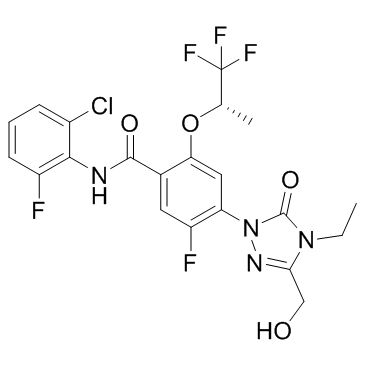| Cas No.: | 2225819-06-5 |
| Chemical Name: | (S)-N-(2-chloro-6-fluorophenyl)-4-(4-ethyl-3-(hydroxymethyl)-5-oxo-4,5-dihydro-1H-1,2,4-triazol-1-yl)-5-fluoro-2-((1,1,1-trifluoropropan-2-yl)oxy)benzamide |
| Synonyms: | BAY 2402234;BAY-2402234;BAY2402234 |
| SMILES: | FC1=C(NC(C2=CC(F)=C(N3N=C(CO)N(CC)C3=O)C=C2O[C@@H](C)C(F)(F)F)=O)C(Cl)=CC=C1 |
| Formula: | C21H18ClF5N4O4 |
| M.Wt: | 520.841 |
| Sotrage: | 2 years -20°C Powder, 2 weeks 4°C in DMSO, 6 months -80°C in DMSO |
| Publication: | [1]. Andreas Janzer, et al. Abstract DDT02-04: BAY 2402234: A novel, selective dihydroorotate dehydrogenase (DHODH) inhibitor for the treatment of myeloid malignancies. AACR Annual Meeting 2018; April 14-18, 2018; Chicago, IL. |
| Description: | BAY-2402234 is a selective dihydroorotate dehydrogenase (DHODH) inhibitor for the treatment of myeloid malignancies. |
| In Vivo: | BAY-2402234 exhibits strong in vivo anti-tumor efficacy in monotherapy in several subcutaneous and disseminated AML xenografts as well as AML patient-derived xenograft (PDX) models. Target engagement of the novel DHODH inhibitor BAY-2402234 can be observed by increase of tumoral and plasma dihydroorotate levels after treatment with the inhibitor. Consistent with the in vitro data BAY-2402234 induces AML differentiation in vivo as detected by upregulation of differentiation cell surface markers in xenograft and PDX models after treatment with the inhibitor. Furthermore, differentiation-associated transcriptomic changes are evident following a single administration of BAY-2402234 in vivo[1]. |
| In Vitro: | BAY-2402234 is a selective low-nanomolar inhibitor of human DHODH enzymatic activity. In vitro, it potently inhibits proliferation of AML cell lines in the sub-nanomolar to low-nanomolar range. BAY-2402234 induces differentiation of AML cell lines also in a sub-nanomolar to low-nanomolar range, demonstrating the anticipated mode of action in cellular mechanistic assays[1]. |

 To enhance service speed and avoid tariff delays, we've opened a US warehouse. All US orders ship directly from our US facility.
To enhance service speed and avoid tariff delays, we've opened a US warehouse. All US orders ship directly from our US facility.




















